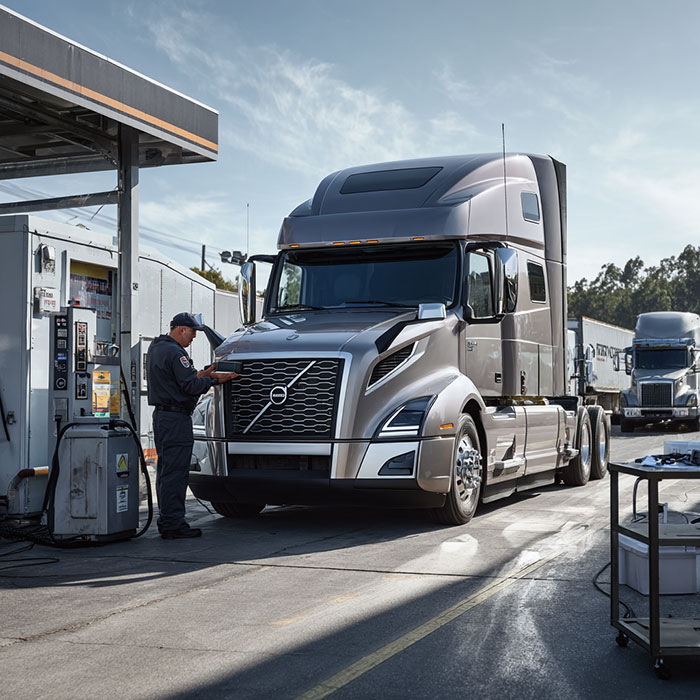
CDL License: The Ultimate Guide to Your Path in Commercial Driving
Navigating the road to obtaining a Commercial Driver’s License (CDL) can sometimes feel like trying to find your way through a labyrinth. Whether you’re an aspiring trucker or considering a career driving buses, limos, or heavy construction vehicles, a CDL is your passport to a whole new world of professional opportunities. That’s where we come in. With years of expertise in CDL training and licensing, SAGE Truck Driving Schools understand the nuances that can make or break your journey.
Why is understanding the ins and outs of a CDL so crucial? A CDL isn’t just a piece of paper; it’s your key to financial stability, independence, and a career that literally takes you places. In this comprehensive guide, we’ll answer your burning questions like: “Where do I start to get my CDL?”, “Which CDL license is the best?”, “What CDL License do I need?”, and most importantly, “Why do you need a CDL?”
Here’s a reality check that should grab your attention: The U.S. Bureau of Labor Statistics projects an increase in the overall employment of truck drivers. What does this mean for you? Simply put, if you have a CDL, you’re stepping into a job market that has room for you. Let’s navigate the highway of opportunities that a CDL opens up, and equip you with the knowledge you need to succeed in this promising field.
Why Do You Need a CDL?
Having a Commercial Driver’s License (CDL) is not just a piece of paper. It’s your ticket to a world of career opportunities in commercial driving. As we cruise down this information highway, let’s start by understanding why you’d need a CDL in the first place.
Legal Requirements
By federal law, anyone operating a commercial motor vehicle (CMV) is required to hold a valid CDL. This mandate ensures that you’ve been trained and tested on the skills needed to safely manage large, complex vehicles. Failure to possess a CDL while driving a CMV can result in hefty fines, legal penalties, and even disqualification from driving commercially.
Risks of Not Having a CDL
Operating a CMV without a CDL isn’t just unlawful — it’s risky. Imagine navigating a 26,000-pound vehicle without proper training. It sounds like a disaster waiting to happen, doesn’t it? Accidents involving commercial vehicles can be catastrophic, both in terms of property damage and loss of life. Having a CDL minimizes those risks by ensuring you’ve received the proper training.
Importance for Commercial Driving Roles
Most commercial driving roles, whether they involve hauling goods across states or transporting passengers within a city, require a CDL. Employers look for this certification as proof of your skills and understanding of road safety protocols. In short, a CDL increases your employability in a wide range of driving roles.
Types of Vehicles Requiring a CDL
Trucks: This includes tractor-trailers, tanker vehicles, and flatbeds.
Buses: School buses, city buses, and long-distance coaches all fall under this category.
Specialty Vehicles: Think tow trucks, garbage trucks, and even certain types of construction equipment.
Owning a CDL isn’t just a legal necessity; it’s a career asset. Whether you’re transitioning into a new career or seeking advancement in your current one, a CDL provides a pathway. Now that you know the ‘why,’ let’s delve into the ‘how,’ which is equally crucial.
Where Do I Start to Get My CDL?
Alright, you’re convinced you need a CDL. But how do you go about getting one? The process can seem overwhelming, especially if you’re new to the commercial driving scene. Fear not; we’ve got you covered.
Before you even think about hopping into the driver’s seat of a commercial vehicle, there are some boxes you’ll need to check. These generally include meeting age requirements and securing the necessary documentation. In most states, you have to be at least 21 years old to drive a commercial vehicle across state lines and 18 years old for intrastate driving (within the same state).
Eligibility Criteria
Age: 18 for intrastate driving; 21 for interstate.
Citizenship: You must be a U.S. citizen or have legal permission to work in the U.S.
Medical Requirements: A physical exam is usually needed, and you’ll often be required to have decent vision and hearing.
Required Documents
Getting a CDL isn’t as simple as walking into your local DMV and asking for one. There’s paperwork — lots of it. Here’s what you’ll generally need:
Identification: Typically, a birth certificate or passport will suffice.
Proof of Residency: A utility bill or lease agreement can usually be used to satisfy this requirement.
Written Test Preparation
Before you get the green light to operate a commercial vehicle, you’ll need to pass a written test to secure your Commercial Learner’s Permit (CLP). Don’t underestimate this test; it’s more demanding than the one for your regular driver’s license. You can prepare by studying the CDL manual and even taking a prep course, which you can find at SAGE Truck Driving School.
The first milestone on your journey to a CDL is passing the written test, which allows you to proceed to the next stages, like on-road training and the skills test. At this point, you’re probably wondering which CDL license is the best for your needs, right? Well, that’s exactly what we’re diving into next. Would you like to proceed?
Which CDL License Is the Best?
Choosing the right type of Commercial Driver’s License (CDL) is crucial because it dictates the kinds of vehicles you’re allowed to drive and the jobs you can take. There are three main classes of CDL: Class A, Class B, and Class C. Let’s break down the differences.
Class A
- Benefits: This license lets you operate a vehicle with a combined gross vehicle weight rating (GVWR) of 26,001 pounds or more. This includes most tractor-trailers, making you eligible for long-haul trucking jobs that often pay well.
- Job Opportunities: Beyond long-haul trucking, Class A licenses can be used for flatbeds, livestock carriers, and even some types of hazardous material vehicles.
- Limitations: This license requires the most rigorous testing, including both a skills and a driving test. Plus, not everyone is cut out for the long hours and extended periods away from home.
Class B
- Benefits: Allows you to operate a single vehicle weighing 26,001 pounds or more, or tow a vehicle not exceeding 10,000 pounds. This makes you eligible for local delivery jobs, bus driving, and garbage truck operations.
- Job Opportunities: Think local. Jobs include delivery services, utility services, and public transportation.
- Limitations: While the testing is slightly less rigorous, job opportunities are often more limited in scope and can be lower-paying than Class A positions.
Class C
- Benefits: If you aim to transport 16 passengers or more (including the driver) or hazardous materials in smaller amounts, this is your go-to license.
- Job Opportunities: School bus drivers, some types of delivery drivers, and passenger van drivers often need a Class C CDL.
- Limitations: This is the most specific and least versatile of the three classes.
Comparison Chart
| Category | Class A | Class B | Class C |
| Weight | 26,001 lbs. or more | 26,001 lbs. or more | Varies |
| Job Scope | Long-haul, versatile | Local, specific | Very specific |
| Testing | Most rigorous | Moderate | Least rigorous |
| Opportunities | High-paying, varied | Local, steady | Specialized, fewer jobs |
By understanding the different CDL classes, you can better assess which one aligns with your career goals and lifestyle preferences.
What CDL License Do I Need?
Now that you know the different classes of CDL licenses, you’re probably wondering which one you actually need. The answer largely depends on what type of commercial driving you’re interested in and what vehicles you’ll be operating.
Based on Vehicle Type
- Heavy Trucks: If you aim to drive heavy trucks, especially for long distances, a Class A CDL is essential.
- Buses and Local Deliveries: For operating large buses or delivery trucks within your local area, a Class B CDL is more suitable.
- Smaller Passenger Vans or Smaller Trucks Carrying Hazardous Materials: A Class C CDL is perfect for driving smaller passenger vehicles that can carry at least 16 people (driver included), or for driving smaller vehicles carrying hazardous materials.
Based on Job Requirement
- Long-Haul Trucking: Definitely a Class A CDL is needed for long-haul jobs. The opportunities in long-haul trucking are plentiful, and the pay is generally better.
- Public Transportation: If you’re looking into becoming a bus driver, especially for your local school district, then a Class B or Class C license could suffice, depending on the size of the bus.
- Special Deliveries: For roles that involve the transportation of hazardous materials in smaller quantities, or special passenger conditions, a Class C license will be required.
Understanding your career aspirations and the type of vehicle you’re interested in driving will guide you in selecting the right CDL license. Whether you see yourself cruising across state lines, making local deliveries, or driving a school bus, the type of CDL you need will set the stage for your future career in commercial driving.
The CDL Training and Testing Process
Getting a CDL isn’t just about choosing the right type of license. You also need to successfully complete the training and testing process. This is a comprehensive journey designed to equip you with the necessary skills and knowledge for a safe and successful career in commercial driving.
CDL Schools
Choosing the right CDL training school is a critical step in your journey. Programs like the one at SAGE Truck Driving Schools offer intensive training modules that cover everything from basic driving skills to advanced road safety measures.
- Hands-on Training: Practical driving sessions where you’re taught how to operate and maneuver the vehicle.
- Theory Classes: These are aimed at helping you pass the written test and include topics like road signs, rules, and vehicle maintenance.
- Specialized Modules: Some schools offer specialized training for driving under different weather conditions, handling hazardous materials, and other specifics.
Road Test
The road test is perhaps the most nerve-wracking part of the CDL process. It’s where you demonstrate your practical skills in operating a commercial vehicle. Tips for acing the road test:
- Pre-Inspection: Know your vehicle well. You’ll be asked to identify various components and may have to explain their functions.
- Maneuvering: Whether it’s parallel parking a 40-foot truck or taking tight turns, make sure you’ve practiced well.
- Safety: Always prioritize safety. Use your signals, watch your speed, and maintain a safe following distance.
Skills Test
The skills test is usually the final hurdle in getting your CDL. It often includes:
- Basic Control Skills: Like your road test but more intensive.
- Vehicle Inspection: Similar to the pre-inspection in your road test but more detailed.
- On-Road Driving: An extended version of the road test covering various types of roadways and traffic conditions.
Successfully passing these tests will earn you the CDL, opening the door to numerous job opportunities in the commercial driving sector.
Renewing and Maintaining Your CDL
Once you’ve gone through the rigorous process of obtaining your CDL, it’s easy to breathe a sigh of relief. However, a CDL is not a one-and-done affair. It requires regular renewals and upkeep to ensure you’re always road-ready and compliant with regulations. Here are some key aspects to keep in mind:
- Renewal Timeline: Typically, a CDL must be renewed every four to five years, depending on your state’s regulations. It’s a good idea to mark the expiration date on your calendar so you can start the renewal process well in advance.
- Renewal Fees: These can vary widely by state but generally range between $60 and $180. Budgeting for this periodic cost is essential.
- Medical Examination: Maintaining an up-to-date Department of Transportation (DOT) medical card is crucial. You’re required to undergo a medical exam every 24 months to renew this card, but some medical conditions may require more frequent evaluations.
- Endorsements and Retesting: If you have any special endorsements on your CDL — like Hazmat or passenger transport — you may need to retake specific tests to renew these endorsements. Some states require retesting for all CDL holders at each renewal.
- Penalties for Lapsed Licenses: If you allow your CDL to expire, there could be significant penalties, including fines and potential disqualification. In some cases, you may even have to go through the testing process again.
- Continued Education: While not always mandatory, some employers encourage or require ongoing education and training. Keeping your skills sharp can make you more marketable and may even lead to pay increases or promotional opportunities.
Conclusion
Congratulations on making it through this comprehensive guide! Obtaining and maintaining a CDL is a journey, not a destination. From figuring out which authorization is best for you to understanding the importance of renewals, we hope we’ve answered your burning questions: Where do I start to get my CDL? Which license is the best? What License do I need? Why do I need a CDL?
With our extensive expertise and experience in the field, SAGE Truck Driving Schools is here to assist you every step of the way. From CDL training programs to permit prep and understanding the admissions requirements, we offer comprehensive guidance to aspiring commercial drivers.
Remember, driving a commercial vehicle is not just about being behind the wheel; it’s about responsibility, legal obligations, and ensuring the safety of everyone on the road. For more details on eligibility, testing, and costs, you can always reach out to us.
What is the cost of CDL training programs?
The cost of CDL training programs can vary widely depending on the school, the type of training, and the geographical location. On average, the cost can range from $3,000 to $7,000 for a comprehensive training program. Some programs might be more expensive, especially if they include additional endorsements or specialized training. Financial aid, scholarships, and company-sponsored training programs are also available options that can help mitigate these costs for aspiring drivers.
How long does CDL training typically take?
The duration of CDL training programs can vary based on the type of license you’re pursuing (Class A, B, or C), the structure of the program (full-time or part-time), and the specific curriculum of the school. Typically, a full-time CDL training program can last from three to six weeks. Part-time programs, naturally, take longer to complete due to the reduced number of hours trained per week. Some specialized training for specific endorsements or advanced driving techniques may require additional time beyond the initial program.
Are there any specific endorsements required for certain jobs within the commercial driving field?
Yes, there are specific endorsements that are required for certain types of commercial driving jobs. Endorsements are added to your CDL to show you have taken additional tests and are qualified to perform specific types of commercial driving work. Common endorsements include:
- H (Hazardous Materials): Required for drivers transporting hazardous materials that require placarding.
- N (Tank Vehicles): Necessary for drivers operating tank vehicles.
- P (Passenger): Required for drivers who will be transporting 16 or more passengers, including the driver, which is typical for bus drivers.
- S (School Bus): Necessary for drivers intending to drive a school bus. This endorsement is in addition to the Passenger endorsement.
- T (Double/Triple Trailers): Required for drivers pulling double or triple trailers.
Each of these endorsements requires passing additional written tests, and in some cases, a skills test. The specific requirements can vary by state, so it’s important to check with the local Department of Motor Vehicles (DMV) or equivalent authority for the precise requirements applicable in your area.
Disclaimer: The information in this article is based on the data available as of its writing and is meant to inform and guide prospective CDL trainees. For the most current information and specifics about CDL training programs, please contact SAGE Truck Driving Schools directly.
Please fill out the information below and our team will reach out to chat about your options.


